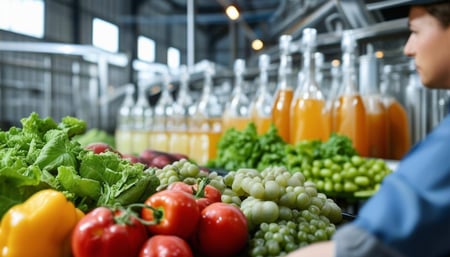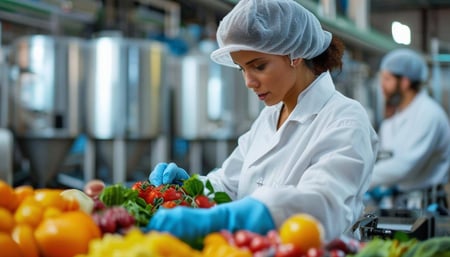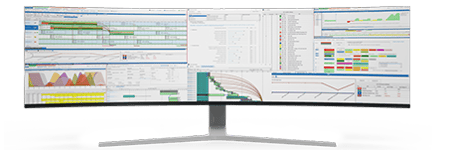Building a Sustainable Workforce Strategy
Sustainability goes beyond environmental practices—it includes how we manage and sustain our workforce in food and beverage manufacturing. With increasing pressure to deliver high-quality products efficiently while navigating labor shortages and fluctuating market demands, having a robust workforce strategy is no longer optional; it is a necessity.
For Plant Managers in the food and beverage industry, a sustainable workforce strategy must be a top priority. Not only does it ensure that operational goals are met, but it also contributes to the long-term success of the plant, enhancing productivity, safety, and employee retention.
The integration of advanced software systems like PlanetTogether and ERP giants such as SAP, Oracle, Microsoft, Kinaxis, or Aveva can significantly elevate the implementation of this strategy. By combining workforce planning, scheduling, and performance optimization, these systems bring automation and real-time analytics to the decision-making process.
In this blog, we will explore how Plant Managers in food and beverage manufacturing can develop and maintain a sustainable workforce strategy, and how integration between PlanetTogether and leading ERP systems can streamline this approach, driving efficiency and sustainability.

The Challenges Facing Workforce Sustainability in Food and Beverage Manufacturing
Labor Shortages: The food and beverage sector faces a labor shortage crisis, exacerbated by aging workforces, pandemic-related disruptions, and difficulties attracting younger talent.
High Turnover Rates: The physically demanding nature of the job and lack of competitive benefits often lead to high turnover rates.
Compliance with Regulations: Stringent food safety regulations require ongoing training and careful workforce management to ensure compliance.
Fluctuating Production Needs: Seasonal changes, consumer demand shifts, and supply chain disruptions mean that workforce needs can vary significantly from month to month.
Skills Gap: With technology evolving rapidly, many manufacturing plants face a skills gap, where the current workforce lacks the expertise to work with new machinery or software systems.
Given these challenges, building a sustainable workforce strategy requires a multi-faceted approach that combines technology with human resource planning.

Key Components of a Sustainable Workforce Strategy
Recruitment and Retention
Attracting Talent: Plant managers should focus on improving the attractiveness of the workplace. This can involve offering competitive wages, providing career advancement opportunities, and creating a positive work culture that promotes employee well-being.
Retention Strategies: A sustainable workforce strategy includes employee retention initiatives, such as continuous training, wellness programs, and employee engagement efforts. It’s crucial to reduce turnover, which can be costly and disrupt production schedules.
Training and Development
Upskilling the Workforce: Investing in continuous learning programs helps employees stay updated with the latest technologies and production processes. This not only improves efficiency but also boosts employee morale, as workers feel more valued and competent in their roles.
Cross-Training: A versatile workforce is essential in managing fluctuating production demands. By cross-training employees to handle multiple roles, plant managers can ensure flexibility and responsiveness to market changes.
Workforce Flexibility
Dynamic Scheduling: The ability to quickly adjust staffing levels in response to production needs is key. This requires flexible workforce management that can adapt to seasonal peaks and drops in demand without overburdening employees or risking under-staffing.
Part-Time and Temporary Workers: Leveraging part-time and temporary staff can help manage periods of high demand. However, these workers should be fully integrated into the workforce strategy, with adequate training and management to ensure product quality and safety are not compromised.
Health and Safety
Workplace Safety: Given the physical nature of work in food and beverage manufacturing, a sustainable workforce strategy must include a strong focus on health and safety. Regular safety audits, ongoing training, and ergonomic assessments can prevent injuries and improve overall worker well-being.
Mental Health Support: Sustainability also extends to mental health. Offering mental health resources, including counseling and stress management programs, helps reduce absenteeism and improves workforce morale and retention.
Data-Driven Decision Making
Real-Time Workforce Analytics: Plant Managers need to leverage data for workforce management. By analyzing production trends, absenteeism rates, and worker performance, plant managers can identify inefficiencies and address issues before they impact production.
Predictive Analytics for Workforce Planning: Forecasting future workforce needs based on historical data can prevent over- or under-staffing, ensuring the plant operates at optimal efficiency.
![]()

The Role of Integration Between PlanetTogether and ERP Systems in Supporting Workforce Sustainability
The integration of advanced planning and scheduling (APS) systems like PlanetTogether with enterprise resource planning (ERP) solutions from SAP, Oracle, Microsoft, Kinaxis, or Aveva is a game-changer for plant managers looking to enhance workforce sustainability. Here’s how these systems work together to streamline and improve workforce management in food and beverage manufacturing:
Automated Scheduling and Resource Allocation
PlanetTogether’s APS software is designed to optimize production schedules by automating the planning process. When integrated with ERP systems such as SAP or Oracle, it can pull real-time data from across the plant, including workforce availability, machine downtime, and production quotas, to create optimized schedules.
For example, a manager can use the integrated system to allocate workers based on their skills and availability, ensuring that the right number of people with the right skill sets are on the floor at any given time. This reduces idle time, prevents overstaffing, and maximizes labor productivity.
Improved Labor Forecasting and Demand Planning
Integrated systems enable plant managers to forecast labor needs more accurately. With tools like PlanetTogether analyzing production trends and ERP systems providing insights into supply chain fluctuations, managers can predict future workforce requirements.
For instance, integrating PlanetTogether with Microsoft Dynamics can provide a clearer picture of how changes in consumer demand (such as during seasonal spikes) will affect labor needs, allowing the plant to adjust staffing levels well in advance. This not only ensures the plant is prepared for demand fluctuations but also prevents burnout from overworking staff during peak times.
Real-Time Monitoring and Workforce Performance Tracking
Integration between PlanetTogether and ERP platforms allows for real-time monitoring of workforce performance. Managers can track metrics such as output per worker, absenteeism rates, and adherence to production schedules. This level of insight helps identify areas where additional training or support may be needed, enhancing overall workforce efficiency.
For example, integrating with a system like Kinaxis can provide real-time data about production constraints, such as bottlenecks caused by machine downtime or labor shortages. By linking this information with workforce data in PlanetTogether, managers can quickly reassign workers or reschedule tasks to maintain production flow.
Enhanced Compliance and Safety Management
Compliance with food safety regulations is non-negotiable in the food and beverage industry. Integration between PlanetTogether and ERP systems can help automate compliance tracking, ensuring that only workers with the necessary certifications and training are assigned to critical tasks.
Oracle’s ERP system, for example, can store and manage employee training records, while PlanetTogether can ensure that only qualified personnel are scheduled for sensitive production tasks. This minimizes the risk of compliance violations and ensures a safer working environment.
Sustainability and Workforce Morale
When integrated properly, PlanetTogether and ERP systems help create more sustainable work environments by reducing the stress of chaotic scheduling, excessive overtime, and unclear job expectations. Employees who work in a well-managed, data-driven environment tend to have higher job satisfaction, which leads to better retention rates—a key aspect of a sustainable workforce strategy.
Moreover, using real-time data from these integrated systems can help managers identify trends that negatively affect employee morale, such as periods of high absenteeism or declining productivity. By addressing these issues promptly, managers can foster a more positive and engaged workforce.
Building a sustainable workforce in the food and beverage manufacturing sector requires a multi-dimensional approach that incorporates recruitment, retention, training, flexibility, and health and safety. By integrating advanced systems like PlanetTogether with ERP platforms such as SAP, Oracle, Microsoft, Kinaxis, or Aveva, plant managers can gain the tools and insights they need to manage their workforce more effectively.
This integration not only optimizes scheduling and resource allocation but also enhances compliance management, improves labor forecasting, and drives better overall performance. In a sector where workforce sustainability is increasingly critical to operational success, leveraging technology to create a smarter, more responsive workforce strategy is not just an advantage—it’s essential for long-term viability.
Are you ready to take your manufacturing operations to the next level? Contact us today to learn more about how PlanetTogether can help you achieve your goals and drive success in your industry.
Topics: PlanetTogether Software, Integrating PlanetTogether, Real-Time Monitoring, Food and Beverage Manufacturing, Enhanced Compliance and Safety Management, Sustainability and Workforce Morale, Automated Scheduling and Resource Allocation, Improved Labor Forecasting and Demand Planning, Workforce Performance Tracking




















LEAVE A COMMENT